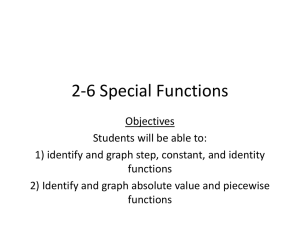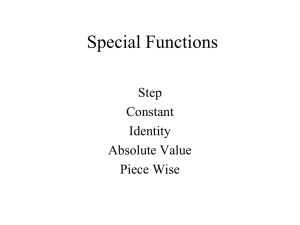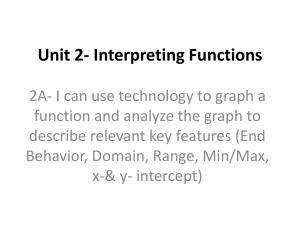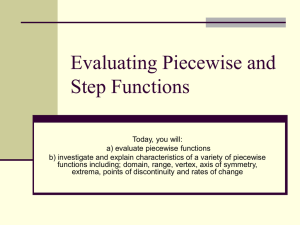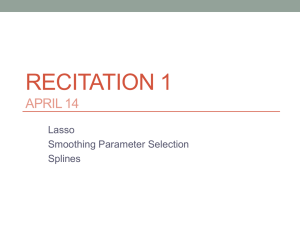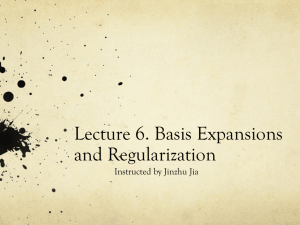Coefficient Path Algorithms
advertisement
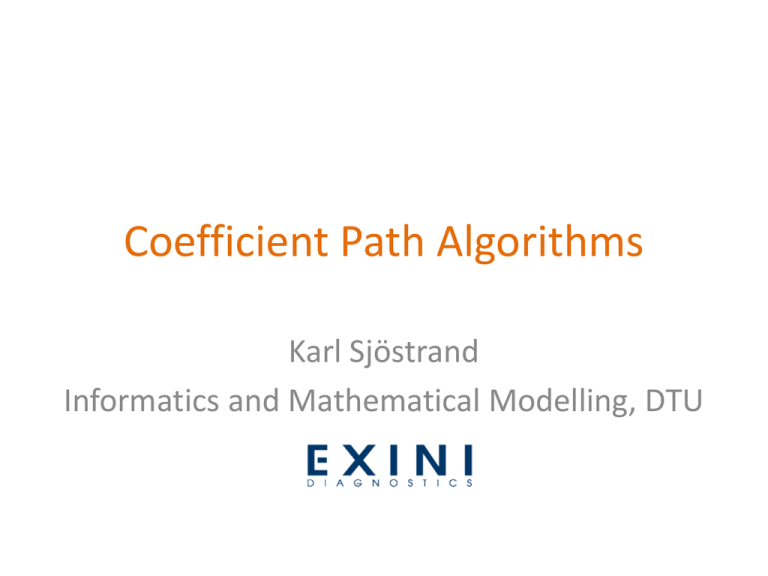
Coefficient Path Algorithms
Karl Sjöstrand
Informatics and Mathematical Modelling, DTU
What’s This Lecture About?
• The focus is on computation rather than
methods.
– Efficiency
– Algorithms provide insight
Loss Functions
• We wish to model a random variable Y by a
function of a set of other random variables
f(X)
• To determine how far from Y our model is we
define a loss function L(Y, f(X)).
Loss Function Example
• Let Y be a vector y of n outcome observations
• Let X be an (n×p) matrix X where the p columns
are predictor variables
• Use squared error loss L(y,f(X))=||y -f(X)||2
• Let f(X) be a linear model with coefficients β,
f(X) = Xβ.
2
T
y
X
β
(
y
X
β
)
(y Xβ )
• The loss function is then
2
• The minimizer is the familiar OLS solution
ˆ arg min L(Y , f ( X )) (XT X) 1 XT y
Adding a Penalty Function
• We get different results if we consider a
penalty function J(β) along with the loss
function
ˆ ( ) arg min L( y, f ( X )) J ( )
• Parameter λ defines amount of penalty
Virtues of the Penalty Function
• Imposes structure on the model
– Computational difficulties
• Unstable estimates
• Non-invertible matrices
– To reflect prior knowledge
– To perform variable selection
• S p a r s e solutions are easier to interpret
Selecting a Suitable Model
• We must evaluate models for lots of different
values of λ
– For instance when doing cross-validation
• For each training and test set, evaluate ˆ ( ) for a
suitable set of values of λ.
• Each evaluation of ˆ ( ) may be expensive
Topic of this Lecture
• Algorithms for estimating
ˆ ( ) arg min L( y, f ( X )) J ( )
for all values of the parameter λ.
• Plotting the vector ˆ ( ) with respect to λ
yields a coefficient path.
Example Path – Ridge Regression
• Regression – Quadratic loss, quadratic penalty
2
ˆ
( ) arg min y Xβ 2 β
ˆ ( )
2
2
Example Path - LASSO
• Regression – Quadratic loss, piecewise linear
penalty
2
ˆ
( ) arg min y Xβ 2 β 1
ˆ ( )
Example Path – Support Vector
Machine
• Classification – details on loss and penalty
later
Example Path – Penalized Logistic
Regression
• Classification – non-linear loss, piecewise
linear penalty
T
ˆ
( ) arg min y Xβ
Image from Rosset, NIPS 2004
n
log1 exp{Xβ} β
i 1
i
1
Path Properties
Piecewise Linear Paths
• What is required from the loss and penalty
functions for piecewise linearity?
ˆ ( )
• One condition is that
is a piecewise
constant vector in λ.
Condition for Piecewise Linearity
600
500
400
()
300
200
100
0
-100
-200
-300
0
200
400
600
800
1000
||()||1
1200
1400
1600
1800
0
200
400
600
800
1000
||()||1
1200
1400
1600
1800
0.4
0.3
d()/d
0.2
0.1
0
-0.1
-0.2
-0.3
-0.4
Tracing the Entire Path
• From a starting point along the path (e.g.
λ=∞), we can easily create the entire path if:
ˆ ( )
–
is known
– the knots where
ˆ ( )
change can be worked out
ˆ ( )
The Piecewise Linear Condition
ˆ ( )
2
2
ˆ
L ( ) J ˆ ( )
J ˆ ( )
1
Sufficient and Necessary Condition
ˆ ( )
2 L ˆ ( ) 2 J ˆ ( )
J ˆ ( )
1
• A sufficient and necessary condition for
linearity of ˆ ( ) at λ0:
– expression above is a constant vector with respect
to λ in a neighborhood of λ0.
A Stronger Sufficient Condition
• ...but not a necessary condition
• The loss is a piecewise quadratic function of β
• The penalty is a piecewise linear function of β
ˆ ( )
2
2
ˆ
L ( ) J ˆ ( )
constant
disappears
J ˆ ( )
1
constant
Implications of this Condition
• Loss functions may be
– Quadratic (standard squared error loss)
– Piecewise quadratic
– Piecewise linear (a variant of piecewise quadratic)
• Penalty functions may be
– Linear (SVM ”penalty”)
– Piecewise linear (L1 and Linf)
Condition Applied - Examples
• Ridge regression
– Quadratic loss – ok
– Quadratic penalty – not ok
• LASSO
– Quadratic loss – ok
– Piecewise linear penalty - ok
When do Directions Change?
• Directions are only valid where L and J are
differentiable.
– LASSO: L is differentiable everywhere, J is not at
β=0.
• Directions change when β touches 0.
– Variables either become 0, or leave 0
– Denote the set of non-zero variables A
– Denote the set of zero variables I
An algorithm for the LASSO
• Quadratic loss, piecewise linear penalty
2
ˆ
( ) arg min y Xβ 2 β 1
• We now know it has a piecewise linear path!
• Let’s see if we can work out the directions and
knots
Reformulating the LASSO
2
ˆ
( ) arg min y Xβ 2 β 1
j j j
p
arg min
y
X
(
)
(
j j)
2
,
2
j 1
subject to j 0, j 0, j
Useful Conditions
• Lagrange primal function
p
p
p
L p : y X( ) ( j j ) j j j j
2
j 1
1
1
j
j
L( )
2
J ( )
Constraints
• KKT conditions
L( ) j j 0, L( ) j j 0
j j 0,
j j 0
LASSO Algorithm Properties
• Coefficients are nonzero only if
• For zero variables L(ˆ ( )) j
L( ˆ ( )) j
I
A
Working out the Knots (1)
• First case: a variable becomes zero (A to I)
• Assume we know the current ˆ and
ˆ
directions
ˆ ( )
ˆ
ˆ
d
0
d min j
ˆ
j
ˆ j /
, j A
Working out the Knots (2)
• Second case: a variable becomes non-zero
• For inactive variables L(ˆ ( )) j change with λ.
2000
1500
|dL|
Second added
variable
1000
500
0
0
200
400
600
800
1000
algorithm direction
1200
1400
1600
1800
2000
Working out the Knots (3)
• For some scalar d,
ˆ
L ( d
)j
will reach λ.
– This is where variable j becomes active!
– Solve for d :
L( ˆ d
) jI L( ˆ d
) iA
(x i x j )T (y X )
d j min
,
(x i x j )T X
d min d j , j I
(x i x j ) (y X )
( x i x j )T X
T
Path Directions
• Directions for non-zero variables
ˆ ( ) A
2 L ˆ ( ) A
J ˆ ( ) (2X X)
1
T
A
1
A
sgn(ˆ ( ) A )
The Algorithm
• while I is not empty
– Work out the minmal distance d where a variable
is either added or dropped
– Update sets A and I
ˆ
– Update β = β + d
– Calculate new directions
• end
Variants – Huberized LASSO
• Use a piecewise quadratic loss which is nicer
to outliers
Huberized LASSO
• Same path algorithm applies
– With a minor change due to the piecewise loss
Variants - SVM
• Dual SVM formulation
1 T
LD : arg max 1
YXX T Y
2
T
– Quadratic ”loss”
– Linear ”penalty”
subject to
0 i 1, i
A few Methods with Piecewise Linear
Paths
•
•
•
•
•
•
•
•
Least Angle Regression
LASSO (+variants)
Forward Stagewise Regression
Elastic Net
The Non-Negative Garotte
Support Vector Machines (L1 and L2)
Support Vector Domain Description
Locally Adaptive Regression Splines
References
• Rosset and Zhu 2004
– Piecewise Linear Regularized Solution Paths
• Efron et. al 2003
– Least Angle Regression
• Hastie et. al 2004
– The Entire Regularization Path for the SVM
• Zhu, Rosset et. al 2003
– 1-norm Support Vector Machines
• Rosset 2004
– Tracking Curved Regularized Solution Paths
• Park and Hastie 2006
– An L1-regularization Path Algorithm for Generalized Linear Models
• Friedman et al. 2008
– Regularized Paths for Generalized Linear Models via Coordinate Descent
Conclusion
• We have defined conditions which help
identifying problems with piecewise linear
paths
– ...and shown that efficient algorithms exist
• Having access to solutions for all values of the
regularization parameter is important when
selecting a suitable model
• Questions?
• Later questions:
– Karl.Sjostrand@gmail.com or
– Karl.Sjostrand@EXINI.com
